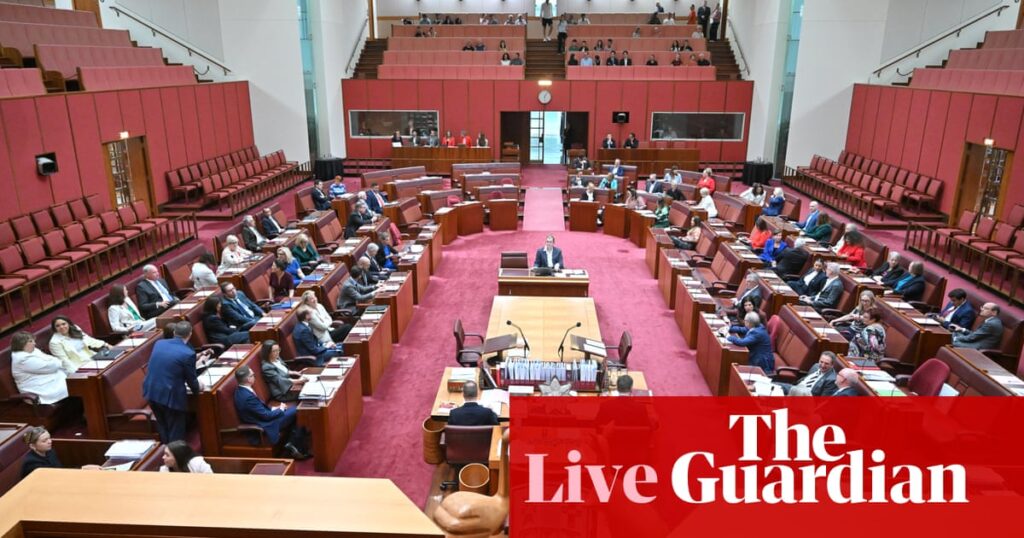Key events
Adam Morton
The government has also released sections of an annual statement to parliament to be delivered today by the climate change minister, Chris Bowen. It focuses on problems with the country’s ageing fleet of coal-fired power stations and the need to make a rapid shift to renewable energy.
According to the excerpts, Bowen will say Australia’s coal fleet is becoming increasingly unreliable, with 90% of capacity expected to retire by 2035. He will say more than 2.5GW of ageing coal-fired capacity was either broken down or out for maintenance during a heatwave this week, forcing the market operator to “juggle the grid” to keep supply going, and there had “not been a single day” in the past 18 months without an unplanned coal-fired capacity outage.
The notion that Australia’s ageing coal fleet should, or in fact could, be relied on to an even greater extent to power our system, is nothing short of magical thinking.
The opposition climate change spokesman, Ted O’Brien, will get to respond to Bowen. He has said a Coalition government would back increased use of coal and gas power, allow less renewable energy than Labor’s planned 82% of generation by 2030, and use taxpayer-funds to build nuclear energy at seven sites.
Critics say this approach would increase costs and emissions and make the power grid less reliable as a single nuclear plant would not be possible until after 2040.
Only five large nuclear projects have reached construction in North America and western Europe this century. Four suffered delays, taking roughly twice as long to build as forecast, and cost somewhere between double and six times initial estimates. The fifth was cancelled.
We’ll bring you more on “climate Christmas” during the day.
Adam Morton
The government has also given journalists a snapshot of a departmental emissions projections report that we expect to be released in full today. The snapshot suggests Australia is on track to meet its 2030 target of a 43% cut in climate pollution below 2005 levels. It says under current policies it should reach at least 42.6%.
We haven’t seen all the numbers underneath that yet, but there is some broad context that we do know, including where the reductions are coming and what is counted towards the target. We have a story setting that out. You can read it here.
The Australian Conservation Foundation’s Annika Reynolds says the headline numbers show the government has made “solid progress” in cutting emissions from electricity generation. But they say the 2030 target is “far too weak” as it is consistent with more than 2C of global heating, and that means “longer heatwaves, more intense bushfires and worse flooding for Australians”.
Reynolds says the government is also allowing further global heating by approving new and extended fossil fuel developments for export.
Approving coal and gas projects is the opposite of climate action.
Adam Morton
Continuing on from the previous post, the government has also released some headline numbers from a separate report by the Australian Electricity Market Commission.
It says household power bills are projected to fall over the next 10 years. In a barely veiled reference to the Coalition’s plan to slow the roll out of large-scale renewable energy, it emphasises that delays in solar and wind being built will increase costs.
It says the AEMC has found that an average household that “fully electrifies” – that is, has solar panels and replaces cars and gas appliances with electric alternatives – could cut their annual electricity spending by 70%, or $3,500.
‘Climate Christmas’ as government releases key reports
Adam Morton
Today is what some people call the Albanese government’s “climate Christmas”, when it releases a handful of reports on the country’s response to the crisis. They include a progress report by the Climate Change Authority, an annual statement by the climate change minister, Chris Bowen, projections of what will happen with emissions between now and 2030 and the quarterly greenhouse gas inventory update.
But wait, there’s more. The government has also promised new figures on renewable energy growth this year from the Clean Energy Regulator and a report on electricity price trends from the Australian Energy Market Commission.
The government has been dripping out selected excerpts from some of these reports over the past couple of days.
They have included a look at the Clean Energy Regulator data. According to what has been released, we should expect a significant boost in the share of electricity coming from renewable energy late next year. This year will set a record for solar and wind installations, with Australia set to add 7.2-7.5GW of capacity. Nearly half of this rooftop solar, mostly on homes.
More than 4.2GW of large-scale renewable energy plants are expected to be approved this year, including the 923MW MacIntyre windfarm in Queensland, which the operators have described as the biggest power station of its type in the southern hemisphere.
The government says the regulator is forecasting that the average share of electricity from renewable energy will reach 45% next year, up from about 39% over the past 12 months. It says:
This significant new generation capacity is mainly wind (70%) and will result in a material step up in the share of renewables as these new power stations reach full generation in the second half of 2025.
Welcome
Good morning and welcome to our live blog from Canberra on what promises to be a very busy day in Parliament House. I’m Martin Farrer, bringing you the best of our overnight stories before Emily Wind gears up to helm the day’s coverage.
The Albanese government is going to try pushing 37 bills through the Senate today as the session heads towards a frantic conclusion. However, a law to increase tax on super balances over $3m will most likely not be among them. We’re reporting exclusively this morning that the government has all but abandoned its contentious plan to increase the tax on superannuation balances over $3m. Guardian Australia understands that the prime minister, Anthony Albanese, fears the policy, planned by the treasurer, Jim Chalmers, could expose Labor to a repeat of the damaging franking-credits campaign that helped cost it the 2019 election.
Among the key pieces of legislation likely to be pushed through today are the government’s trio of migration bills giving government extensive powers, from deporting non-citizens to allowing sniffer dogs in immigration detention centres. They have been supported by the Coalition amid strong condemnation from rights advocates and today we hear from Priya Nadesalingam, the Tamil woman who won a long fight for her and her family to stay in Australia. She says the government’s immigration detention bill would have made it “impossible” for her to succeed and enable her family to return to Biloela in Queensland.
Today is known in some parts as “climate Christmas” because the government is releasing a slew of reports detailing where Australia is at with its attempts to tackle the climate crisis. These include a projection on emissions between now and 2030; Chris Bowen to claim that “fully electrified” households will see bills fall for the next 10 years, and the state of the country’s fleet of ageing coal-fired power stations. More details coming up.
Premium IPTV Experience with line4k
Experience the ultimate entertainment with our premium IPTV service. Watch your favorite channels, movies, and sports events in stunning 4K quality. Enjoy seamless streaming with zero buffering and access to over 10,000+ channels worldwide.

















